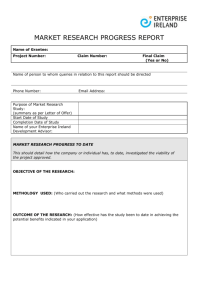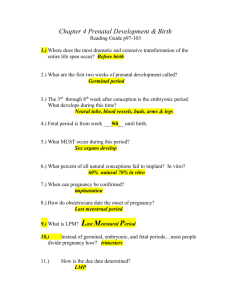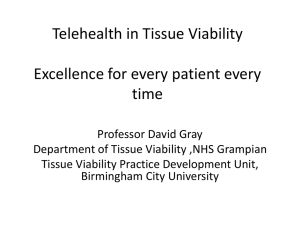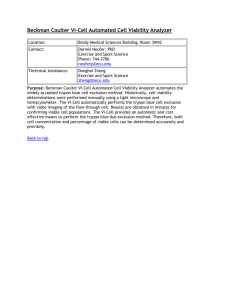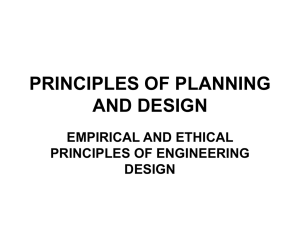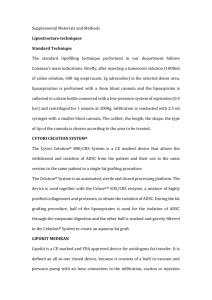Viability of VASER® lipoaspirate for AFT or Regenerative Cell
advertisement
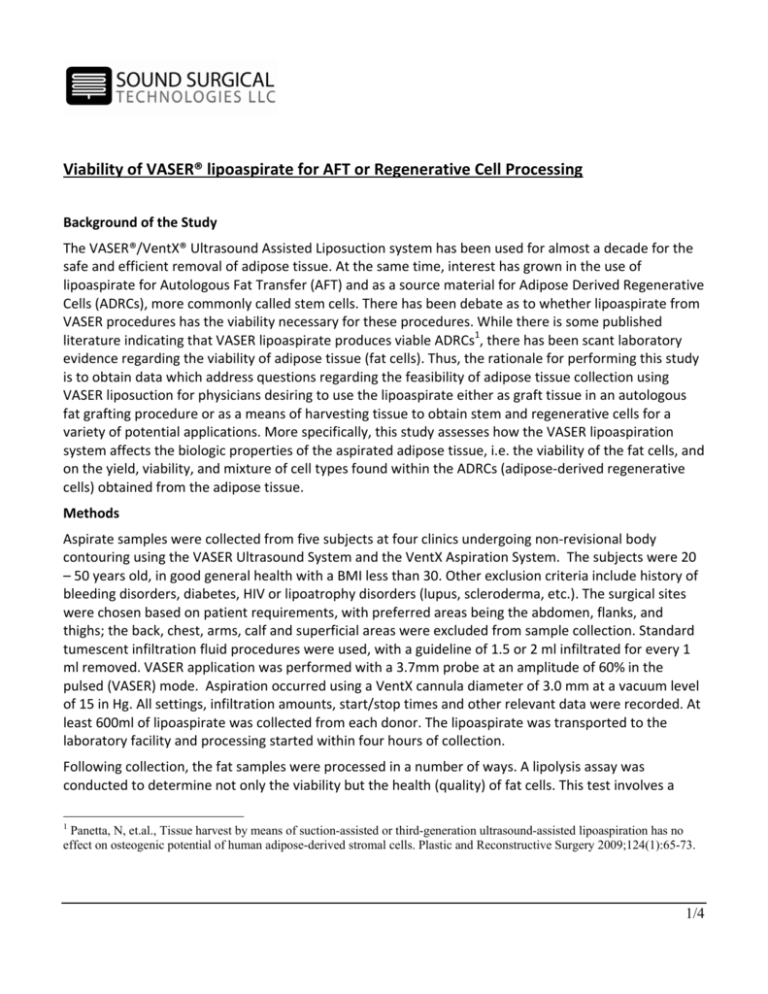
Viability of VASER® lipoaspirate for AFT or Regenerative Cell Processing Background of the Study The VASER®/VentX® Ultrasound Assisted Liposuction system has been used for almost a decade for the safe and efficient removal of adipose tissue. At the same time, interest has grown in the use of lipoaspirate for Autologous Fat Transfer (AFT) and as a source material for Adipose Derived Regenerative Cells (ADRCs), more commonly called stem cells. There has been debate as to whether lipoaspirate from VASER procedures has the viability necessary for these procedures. While there is some published literature indicating that VASER lipoaspirate produces viable ADRCs1, there has been scant laboratory evidence regarding the viability of adipose tissue (fat cells). Thus, the rationale for performing this study is to obtain data which address questions regarding the feasibility of adipose tissue collection using VASER liposuction for physicians desiring to use the lipoaspirate either as graft tissue in an autologous fat grafting procedure or as a means of harvesting tissue to obtain stem and regenerative cells for a variety of potential applications. More specifically, this study assesses how the VASER lipoaspiration system affects the biologic properties of the aspirated adipose tissue, i.e. the viability of the fat cells, and on the yield, viability, and mixture of cell types found within the ADRCs (adipose‐derived regenerative cells) obtained from the adipose tissue. Methods Aspirate samples were collected from five subjects at four clinics undergoing non‐revisional body contouring using the VASER Ultrasound System and the VentX Aspiration System. The subjects were 20 – 50 years old, in good general health with a BMI less than 30. Other exclusion criteria include history of bleeding disorders, diabetes, HIV or lipoatrophy disorders (lupus, scleroderma, etc.). The surgical sites were chosen based on patient requirements, with preferred areas being the abdomen, flanks, and thighs; the back, chest, arms, calf and superficial areas were excluded from sample collection. Standard tumescent infiltration fluid procedures were used, with a guideline of 1.5 or 2 ml infiltrated for every 1 ml removed. VASER application was performed with a 3.7mm probe at an amplitude of 60% in the pulsed (VASER) mode. Aspiration occurred using a VentX cannula diameter of 3.0 mm at a vacuum level of 15 in Hg. All settings, infiltration amounts, start/stop times and other relevant data were recorded. At least 600ml of lipoaspirate was collected from each donor. The lipoaspirate was transported to the laboratory facility and processing started within four hours of collection. Following collection, the fat samples were processed in a number of ways. A lipolysis assay was conducted to determine not only the viability but the health (quality) of fat cells. This test involves a 1 Panetta, N, et.al., Tissue harvest by means of suction-assisted or third-generation ultrasound-assisted lipoaspiration has no effect on osteogenic potential of human adipose-derived stromal cells. Plastic and Reconstructive Surgery 2009;124(1):65-73. 1/4 glycogen challenge and a measure of the corresponding response. ADRC analysis was performed by first using the Celution® 800/CRS Processing system to extract ADRCs, and then using the NucleoCounter™ assay to determine the number and viability of the ADRCs present. The Cytori Puregraft™ system was also used to wash the samples, followed by centrifugation. Volumes of aqueous phase, tissue, and free lipid were measured and recorded. Samples were also assessed after freezing in liquid nitrogen vapor. Results Patient and Sample Information: The table below presents the patient and sample information for this study. Gender Age Harvest Site Aspirate Volume (ml) F 24 abdomen, flanks 1,700 F 28 right flank, left flank 730 F 45 flanks, thighs 800 F 43 Flanks, inner thighs 800 F 38 thighs 1,500 Adipocyte Viability: The first figure below shows the adipocyte viability of the unprocessed samples. The mean value was 85.1 % ± 11.0%. The samples had an average of more than 32,000 loosely adherent cells per gram of tissue, which is a measure of the ancillary cells which accompany fat cells in the lipoaspirate (these cells are thought to be important in the reimplantation process). Immediately after harvesting, the VASER aspirate had an aqueous content of 20.7% ± 2%, and a free lipid content of 5.29% ± 1.8%. After processing in the PureGraft system, the aqueous and free lipid content were reduced to 16.5% ± 3.5% and 0.63% ± 0.5%, respectively. After processing in the Celution® system, the mean viability of ADRCs was found to be 87.4% ± 4.58% (as shown in the second graph), with an average density of 1.81 ± 0.34 x 105 cells/gm. Post‐freezing, the viability of ADRCs dropped an average of only 11%, and the net recovery after cryopreservation was slightly over 50%. 2/4 Adipocyte Viability: Functional Assessment by Lipolysis Assay 97 100 92.1 84.4 85.1 83.7 80 Viability (%) 68.1 60 40 20 0 Pt 1 Pt 2 Pt 3 Pt 4 Pt 5 Mean 87 87.4 Pt 5 Mean ADRC Viability 100 94 89 85 82 Viability (%) 80 60 40 20 0 Pt 1 Pt 2 Pt 3 Pt 4 3/4 Discussion An increasing number of physicians are exploring the use of autologous fat transfer or fat grafting procedures to provide lasting natural structure and contour changes. By removing many of the rejection complications associated with artificial implants, autologous fat transfer presents fewer side effects in the longer term. For these fat transfers, the viability of the harvested tissue is of primary importance. Traditionally, physicians have used hand‐held syringes. This method is both laborious and time consuming; and depending upon the size of the needle and syringe used, may still disrupt fat cells. In this series, we used a standard VASER treatment followed by low‐vacuum aspiration using the VentX system and achieved a raw fat viability of 85%. This high level of viability did not come at the expensive of operative time or convenience. An important factor in the viability is the use of the VASER to break apart the fat tissue before aspiration. Separating the adipose tissue into smaller clumps in situ permits the use of atraumatic canulae and lower vacuum levels, which in turn, avoids tearing or shearing the fat during aspiration. Also, by maintaining the overall cellular distribution of the lipoaspirate (mature adipocytes and the “loosely adherent“ cell population (peri‐adipocytes, stem cells, stromal cells, etc.), the success rate of the implanted tissue matrix is enhanced. In addition to the use of harvested fat for immediate re‐injection, adipose tissue is a significant source of stem cells2 for both enhancement of autologous fat grafts3 and for use in other developing clinical treatments. As with direct autologous fat injections, the viability of the regenerative cells derived from the harvested adipose tissue is of primary importance, both as fresh tissue and after freezing. The field of clinical treatments using adult stem cells continues to expand and patients undergoing liposuction are increasingly interested in storing tissue samples containing stem cells. These cells could then be thawed at some future date and utilized in the development of genetic and tissue based treatments. The viability of the adipose‐derived stem cells was higher than that for the overall tissue samples and over 87%. More importantly, the viability of the adipose‐derived stem cells was only slightly reduced to 75% after freezing using liquid nitrogen vapor. In this application, the separation of the cells using the VASER System minimizes tissue damage and improves the viability of the harvested cells. Conclusion The VASER Ultrasound System and the VentX Aspiration System provide an efficient means of harvesting adipose tissue without sacrificing tissue viability. 2 Strem BM, et.al., Multipotential diffentiation of adipose tissue-derived stem cells. Keio J Med. 2005;54(3):132-141. Tiryaki T, Findikli N, Tiryaki D. Staged Stem Cell-enriched Tissue (SET) Injections for Soft Tissue Augmentation in Hostile Recipient Areas: A Preliminary Report. Aesth Plas Surg. 2011 Apr 13 [Epub ahead of print]. 3 4/4
